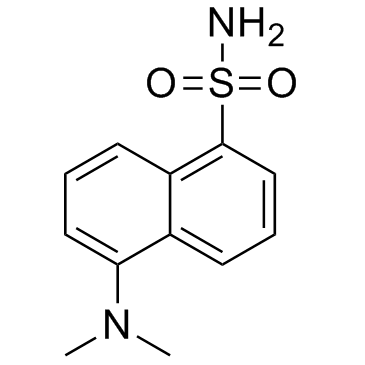Thiol dependent isomerization of bovine albumin
María Gabaldon, María Gabaldon
Index: Int. J. Biol. Macromol. 44(1) , 43-50, (2009)
Full Text: HTML
Abstract
Albumin isomerizes to the aged form in the presence of cysteine at pH 8.9 and low ionic strength. Albumins with a high fatty acid and Cu(II) content do not produce isomers, and recover this capacity after an acid expansion. Isomers have the free thiol group fully oxidized (non-mercaptalbumin) and have been isolated for the first time from aged albumins by anion and cation exchange chromatography. Isomers have a higher susceptibility to limited tryptic digestion and show a decrease in the fluorescence of bound dansylamide, a typical marker of site I. Aging in the presence of phenylarsine oxide, which complexes vicinal thiols, impairs the formation of isomers and increases the free –SH groups of albumin.
Related Compounds
| Structure | Name/CAS No. | Molecular Formula | Articles |
|---|---|---|---|
 |
Dansyl amide
CAS:1431-39-6 |
C12H14N2O2S |
|
Macromolecular Systems with MSA-Capped CdTe and CdTe/ZnS Cor...
2015-11-11 [ACS Appl. Mater. Interfaces 7 , 24778-90, (2015)] |
|
Alteration of human serum albumin tertiary structure induced...
2016-01-15 [Spectrochim. Acta. A. Mol. Biomol. Spectrosc. 153 , 560-5, (2015)] |
|
Optimizing Multiple Analyte Injections in Surface Plasmon Re...
2015-01-01 [Sci. Rep. 5 , 15855, (2015)] |
|
Nutritional and health-promoting properties of bean paste fo...
2015-11-01 [Food Funct. 6 , 3560-6, (2015)] |
|
How many antimicrobial peptide molecules kill a bacterium? T...
2014-09-19 [ACS Chem. Biol. 9(9) , 2003-7, (2014)] |